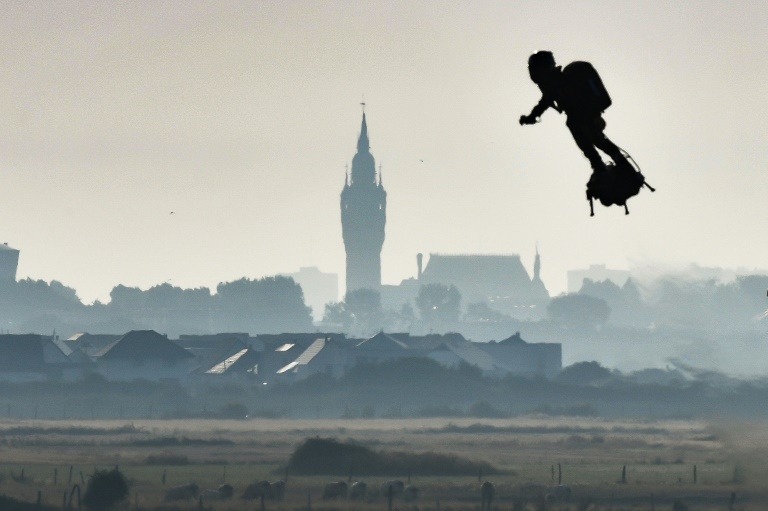
'Everyone wants to fly'. (Photo: AFP)
A French daredevil who spent years developing a jet-powered hoverboard zoomed across the English Channel on Sunday, fulfilling his quest after pulling off a tricky refuelling manoeuvre that cut short his first attempt 10 days ago.
Franky Zapata blasted off on his "Flyboard" from Sangatte on the northern coast of France at 8:17 am (0617 GMT) for the 35-kilometre (22-mile) trip to St. Margaret's Bay in Dover.
Escorted by three helicopters, he soared across the water in the early morning light and landed 22 minutes later in the picturesque bay, to the applause of dozens of onlookers and journalists.
"I'm feeling good. I'm feeling happy, I'm feeling lucky. This is just an amazing moment for me," Zapata told AFP after landing.
He said the indicators in the visor of his helmet showed he raced over the busy shipping lane at a speed of 160-170 km/h (100-105 mph), doing zig-zags as he neared the coast to try to ease the fatigue in his legs.
Minutes after descending from the metal platform where he landed his craft, Zapata broke down in tears of emotion while talking on the phone to his 10-year-old son, who could be heard saying, "Dad, you're the best!"
"I was almost at my limits -- there was still enough fuel in my pack for another 10 kilometres or so. Maybe I could have done five or six," Zapata said later at a press conference back in Sangatte.
"People are passionate about this, everyone dreams about flying," he said, recalling his fascination with the hoverboard in the 1985 hit movie "Back to the Future," set in 2015.
"And then 2015 came around, and there were still no hoverboards, so we said 'OK, we're going to do it'."
'My dream'
Zapata, a 40-year-old former jet-ski champion, made his first attempt on July 25, to coincide with the 110th anniversary of Louis Bleriot's historic first crossing of the Channel by plane.
But he had to be fished from the water after failing to land on a boat to refuel -- his backpack carries some 35 kilogrammes (77 pounds) of kerosene, enough to keep him aloft for around 10 minutes.
Asked if he considered himself Bleriot's successor, Zapata told BFM television: "It's not really comparable, he was one of the first men to fly."
"Let's just say that I achieved my dream."
This time the refuelling boat was bigger and had a larger landing area, and French navy vessels in the area kept an eye out in case of trouble.
Zapata said he and his team had worked around to clock to repair the hoverboard and its five turbines after it was damaged from falling in the Channel waters 10 days ago.
Flying car in the works
Zapata has been working on the hoverboard for the past three years, despite losing parts of two fingers during its maiden flight in his garage near Marseille, when they got sucked into the turbines.
He already holds the Guinness World Record for the farthest hoverboard flight, a 2.2-kilometre trip over the Mediterranean Sea in April 2016.
No Guinness adjudicator was on hand for the latest Channel attempt, though a spokeswoman said he could still be awarded a new record if the trip meets its guidelines.
Zapata burst into the spotlight at this year's July 14 Bastille Day military parade in Paris, where he buzzed above a crowd of stunned onlookers that included French President Emmanuel Macron.
His device has also captured the attention of the French defence ministry, which in December gave Zapata's company, Z-AIR, a 1.3 million euro ($1.4 million) development grant, in particular for improving the turbines.
"It's not the return of the 'Avengers', it's a reality. Bravo Franky Zapata," Defence Minister Florence Parly tweeted after Zapata's feat.
Zapata eventually hopes to soar into the clouds at altitudes well above the 15 to 20 metres (50-65 feet) currently -- something that will require him to figure out how to carry a parachute, guidance equipment and possibly an oxygen tank.
But he is aiming even higher: This year he hopes to unveil a 10-turbine flying car that would be easy enough for anyone to pilot, without requiring the physical strength and long hours of practice to master the Flyboard.
"We expect to have the authorisations for test flights in the coming days," he said back in Sangatte, adding that it would initially have a range of 100-120 kilometres.
"We're going to take a bit of holiday... and then the whole team will get back to work so it's ready on time."


